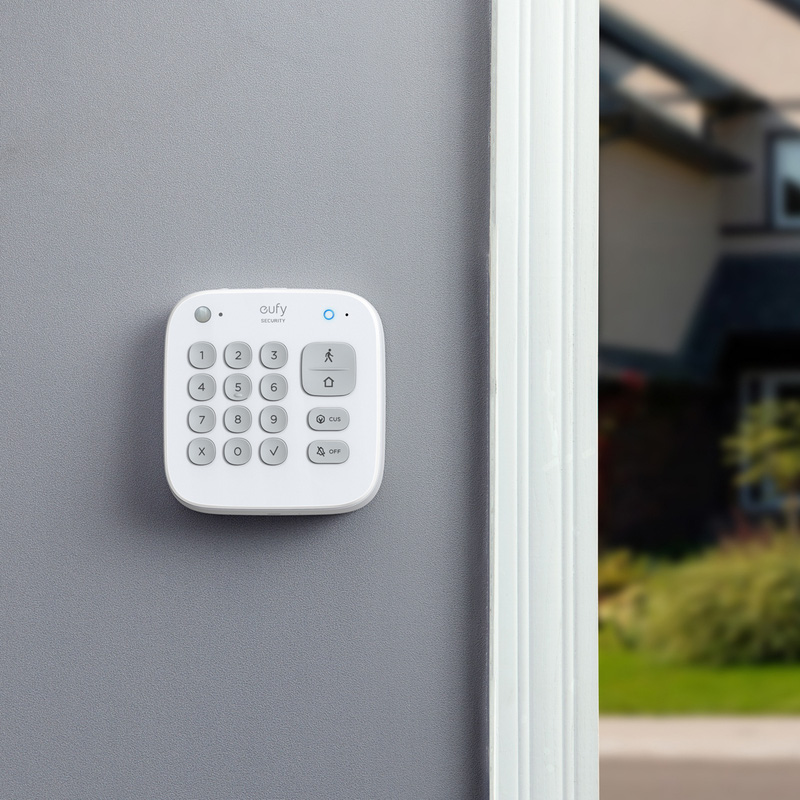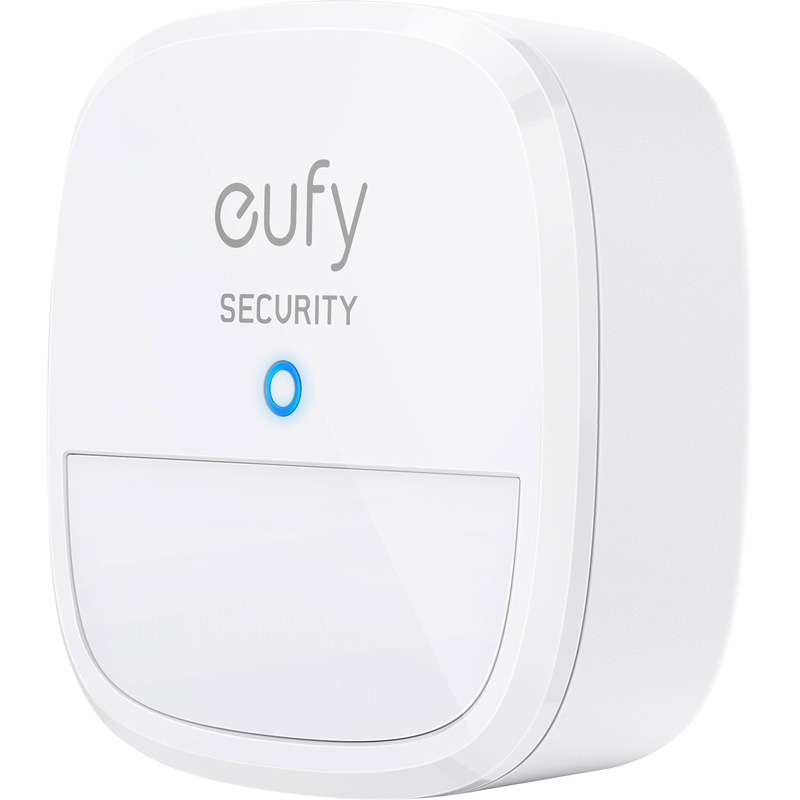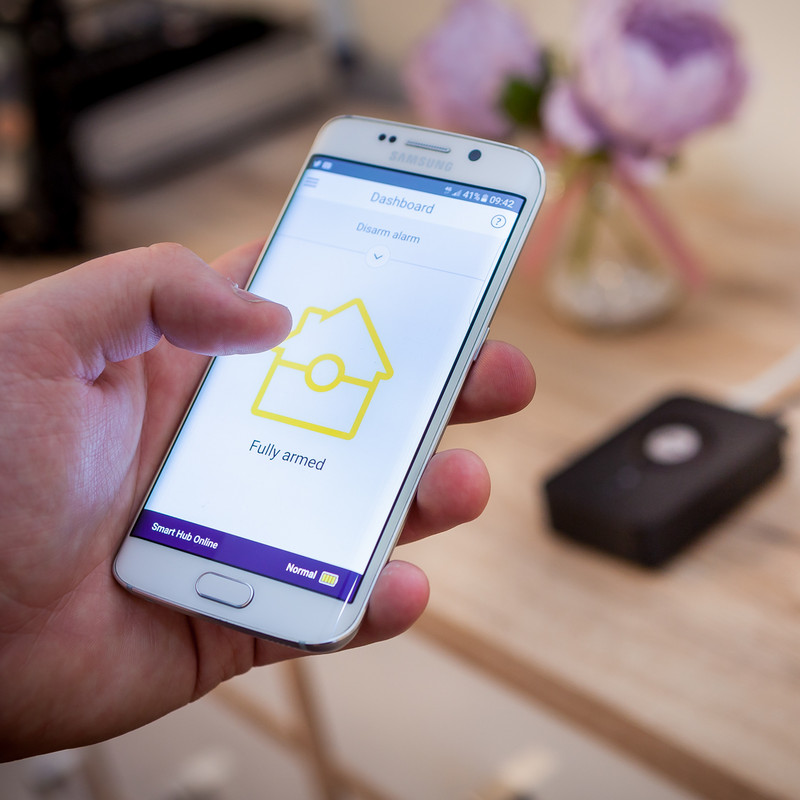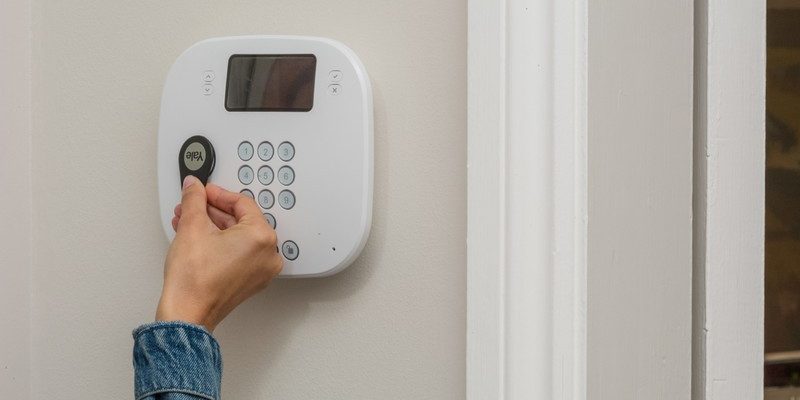Burglar alarms are the simplest solution to deter intruders from your home – whether that’s preventing them from entering your home in the first place, or ensuring they flee when the alarm is triggered. No matter what type of Burglar alarm you choose, they can make you feel safe, protect your belongings from theft, and even reduce your home insurance premium.
Security alarms are made up of three components: a sensor detects movement, a control panel activates and deactivates the alarm, and a siren alerts you and your neighbours to the intrusion. These three components can connect in two ways: wired or wireless (using Bluetooth or WiFi), and sometimes a combination of both. Newer to the market are smart alarms, a type of mostly-wireless security, which interconnects to other security devices on your property and sends notifications to your smart device.
As well as investing in an efficient door lock, the best way to protect your property is to have a combination of sensors connected to your control panel and siren. Contact sensors to alert you when a door or window is opened, and motion sensors to detect when an intruder is already in the home.
How Do Burglar Alarms Work?
Burglar alarms work by activating an alarm system when sensors detect movement within the property, or when someone attempts to open a door or window. Most burglar alarm systems use three components: a control panel, sirens, and sensors – which all work together to keep you and your home safe.

Control Panels
Control panels are the core component of burglar alarm systems. They link to all sensors and activate the alarm when an intruder is detected. Typically, control panels have keypads that allow you to set and disarm the alarm using a code. Some control panels can also be operated using key fobs.

Sirens and Sounders
Most burglar alarm sirens will fit into one of two categories: indoor sirens or outdoor beacons. Indoor sirens are intended to scare off intruders if they’re inside your property, while outdoor beacons will alert the neighbourhood to a break in. Outdoor sirens can also act as a deterrent before a potential break in, as amateur burglars may look for houses that don’t have a siren installed.

Sensors
Last but not least, sensors work to detect intruders entering or attempting to enter a property. If a sensor detects motion, infrared radiation, or an open door or window, it sends a signal to the control panel. The control panel will then activate the alarm in response.
Types of Burglar Alarms

PIR Sensors
Passive Infrared (PIR) Sensors detect infrared radiation given off by a person and respond by sounding the alarm. They split a room into a grid, and are triggered if they detect IR radiation moving from one square to another. Pet-friendly options work by either not detecting IR near the ground, or only detecting radiation above a certain size.
PIR sensors can be used for domestic or business purposes, and are suitable for any room of a home. They’ll pick up IR radiation in the dark – which is especially important when you’re asleep and less alert to potential burglars. They’re versatile too - able to be used alone or as part of a wider system.
They're only triggered once an intruder is inside, rather than stopping them getting in. Pets can trigger the alarm as they also emit IR radiation, which can lead to false alarms. However, this can be reduced with a pet-friendly model. You may also find they’re less sensitive when the room temperature gets closer to human body temperature (in the summer months).
Advantages
-
Better than CCTV, especially in the dark
-
Can be used alone or in a complete system
Things to Consider
-
Some models can be triggered by pets
-
Won't alert until the intruder is already in
-
Could be less sensitive in the summer

Contact Sensors
Contact alarms are made of two pieces: a magnet and a sensor. One piece is placed on a window, and the other piece is attached to the window frame. When a door or window is opened, the magnet is separated from the sensor piece which triggers the alarm. Contact sensors can be used on any surface that may be opened from the outside, both in domestic and business environments.
Contact alarms have a high level of accuracy, as they can only be triggered when the magnet and sensor are disconnected. These sensors sound the alarm the instant the connection is broken, so they keep intruders out before they enter. Contact sensors can be used alone or as part of a wider security system.
These sensors only protect from intruders where they're installed - which is most commonly ground-floor windows and doors. This means any windows and doors, such as upstairs windows, that don't have contact sensors can be broken into without activating the alarm. It's best to use a combination of contact sensors and motion sensors to ensure you're covered.
Advantages
-
High level of accuracy
-
Keep intruders out of your property to begin with
-
Can be used alone or as part of a wider system
Things to Consider
-
Only triggered on windows they're installed on

Motion Sensors
Motion sensors consist of two parts - the transmitter and the receiver. The transmitter emits soundwaves at a frequency higher than humans can hear (usually between 30kHz to 10MHz). These soundwaves bounce off objects in the path of the sensor before being detected by the receiver. When a human enters the room, the soundwaves bounce off them, and the time it takes for the waves to reach the receiver changes, triggering the alarm.
Ultrasonic motion sensors can be used inside commercial or residential buildings. They can be used in the dark and are not affected by dust, dirt, or high moisture in the air.
Like PIR motion sensors, the alarm won’t be triggered until after the intruder has entered the building – rather than contact sensors which will detect before the burglar gets inside. Ultrasonic motion sensors may also be affected by very soft fabrics, as they absorb more sound, which could reduce their effectiveness in rooms such as bedrooms.
Advantages
-
Commercial or residential use
-
Can be used in the dark
-
Not affected by dust, dirt, temperature changes or humidity
Things to Consider
-
Could be affected by soft fabrics that absorb more sound
-
Can’t detect an intruder before they get inside
Wired vs. Wireless Burglar Alarms
The difference between wired and wireless systems is determined by how the sensors connect to the control panel, and how the equipment is powered. Most modern burglar alarms are at least semi-wireless, using WiFi or Bluetooth to connect to the control panel, and a battery or mains supply for power.
Wired Burglar Alarms
Wired alarms are powered by the mains supply and each element is connected via cables running around the property. They're less commonly used in residential environments because they require hardwiring into the electrical system, which needs professional installation and can be costly.
Wired alarms aren’t affected by batteries dying or WiFi connections going down, making them arguably more reliable than wireless alternatives. They also tend to be cheaper to buy outright, and there are fewer batteries to keep an eye on and regularly replace.
The main consideration with wired burglar alarms is the potential for wires to be tampered with by potential intruders or damaged by pests – although modern systems will often alert you if this happens. You can’t easily take wired alarms with you to new premises, and wiring into an older property can be more complicated than a wireless system.
Advantages
-
Not affected by batteries dying or WiFi connections going down
-
Tend to be lower cost to buy outright
-
Fewer batteries to replace
Things to Consider
-
Wires can be tampered with or be damaged by pests
-
Can’t easily take it with you to new premises
-
Hardwiring will need lengthy and potentially costly installation
Wireless Burglar Alarms
Wireless burglar alarms are powered by WiFi or another type of wireless technology such as Bluetooth. They’re a common security device for residential properties as they're easy to install and disassemble if they need to be moved.
Wireless alarms often look neater than wired alarms, as there's no trunking or wires around the home. They’re also easier to move around if you’re redecorating or moving house, and you can often add extra security features to them such as proactive sensors like contact alarms, or door and window vibration sensors.
It’s important to consider that if the WiFi or other connection goes down, you could lose security which may put your property at risk – although many models will also operate on battery as a back-up. You’ll also need to keep an eye on and replace the batteries when needed – failing to do so could leave your home unprotected!
Advantages
-
Easy and quick to install and move around if needed, such as moving house or redecorating
-
Tend to look neater, with no wires or trunking around the home
-
Easier to extend or add extra security features, such as proactive sensors
Things to Consider
-
If WiFi goes down, you could lose security
-
Will need to keep an eye on and replace batteries when needed
Smart Home Security
Upgrading to the latest smart home technology? Smart security uses WiFi and smartphone apps to allow you to control your system from anywhere. What's more, most smart security devices come as all-in-one kits to get you started, with the flexibility to add more devices over time if needed.

Smart Burglar Alarms
Smart alarms are a type of security system you can control through your smartphone - meaning you’ll be notified directly via your smart device if it detects an intruder. They’re usually wireless and often include a keypad to activate and deactivate the alarm, siren alarm, and smart motion sensors. These sensors will either work by detecting infrared radiation from people or by changing soundwaves, depending on the system.
Smart alarms are used around the home and wider property, and can be interconnected to other smart security devices such as proactive contact sensors, glassbreak detectors, and door vibration sensors. They’re easy to use and install, and you can choose which parts you want to buy and install to complete your security system, making them highly flexible. Smart alarms allow for remote troubleshooting and security, so you can keep an eye on your property from thousands of miles away.
These alarms require incredibly strong passwords to avoid being hacked into, as hacking could be devastating and dangerous for your home security. You may also find that smart alarms come at a higher upfront cost than standard burglar alarms.
Advantages
-
Interconnect to lots of security devices, including proactive sensors
-
Remote troubleshooting and security – see what’s going on via your smart device
-
Easy to use and install
Things to Consider
-
Requires very strong passwords, as weak passwords could jeopardise your safety
-
Higher upfront cost than standard alarms
Key Burglar Alarm Features
Control Method
Your burglar alarm control method will likely be one of two types: a keypad or via a smart device. A keypad can be armed and disarmed manually, usually near the entrance of your property – they can be wired or wireless. A smart alarm can be armed and disarmed from anywhere - which can provide you with more peace of mind.
Pet-Friendly Sensors
Pet-friendly burglar alarms will limit false positives from your four-legged friends. Pet-friendly sensors can cut off the lower half of the room so your cat or dog can wander around freely on the ground. Alternatively, the sensors will only detect IR radiation on living beings above a certain size. If you have a larger pet or they jump on the furniture, you may find that motion sensors are less suitable.
Complete Systems
Complete systems include a range of security devices such as motion detectors, window sensors, sirens, panic buttons, even CCTV cameras to keep the home safe. These will give you a high level of security for your home by protecting you from a range of intrusion methods.
Remote monitoring
Remote maintenance can mean two things – with smart alarms, it can mean you’re able to keep an eye on your property from your smart device. Alternatively, some alarms can be monitored remotely by a company that will keep an eye on your home if the alarm is triggered.








